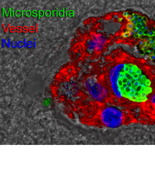|
| |

 |
|
 |
  Microsporidiosis Microsporidiosis
Division of Microbiology
Natural History of Microsporidial Infections and Therapeutic Approaches
Microsporidia are single-celled parasites associated with diarrhea and systemic disease in animals and humans worldwide. Horizontal, zoonotic, waterborne, and food borne modes of transmission occur, thereby resulting in targeted research on the microsporidia by the U.S. Environmental Protection Agency in response to the Safe Drinking Water Act and by the National Institutes of Health and Centers for Disease Control and Prevention in response to the potential bioterrorist threat of these organisms. Research on microsporidiosis in the Division of Microbiology focuses on infection of humans and nonhuman primates by species of microsporidia, namely Enterocytozoon bieneusi and three Encephalitozoon species. Studies are being conducted to improve diagnostic tests as well as to characterize the natural history and pathogenesis of these infections. These studies serve to better understand the course of microsporidial infections in humans. Effective therapies are lacking to treat all the microsporidia that infect humans and animals, but fumagillin and related compounds show great potential. Toxicity concerns, however, have led to studies to clone, express, and characterize methionine aminopeptidase 2, the putative fumagillin target of the microsporidia, and to develop a high throughput screening assay that can be applied to identify more effective and less toxic fumagillin analogues. Tissue culture and murine and nonhuman primate models of microsporidiosis are being used for preclinical testing to evaluate efficacy and toxicity of lead compounds. In addition, immune responses are being defined in these models to better understand the mechanisms by which T cells and macrophages interact to kill microsporidia. Finally, methods are being developed and applied to capture and identify microsporidia in water sources that pose a potential risk for transmission to humans and animals.
|
 |
|
|
